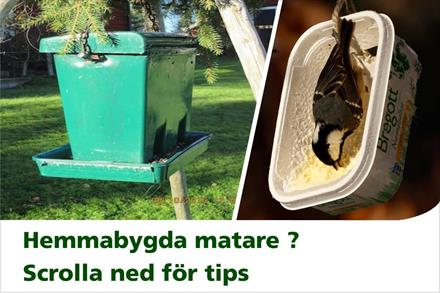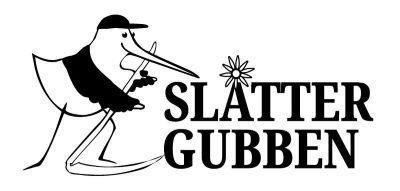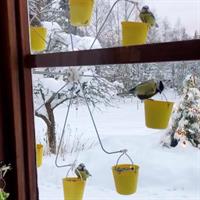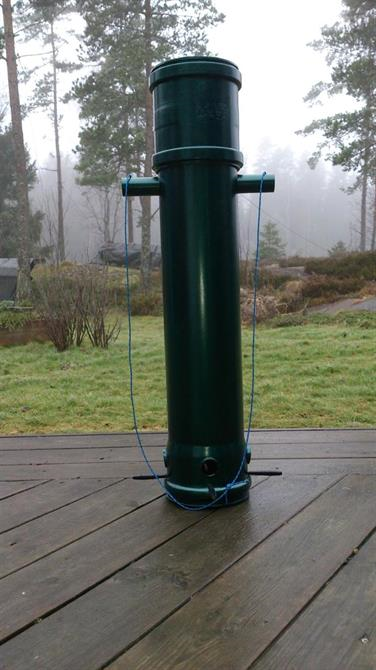Bird feeder – buy one or make your own!

I'm not exactly proud to sell imported plastic bird feeders from China. They are not unique and require no skill. I have selected a few bird feeder tubes, birdhouses, and accessories for hanging - BUT they are in no way "more environmentally friendly" with us than if you buy from someone else. However, you are supporting an honest and aware company. The bird feeders I like the most are:
The Ferris Wheel - the quirky, Swedish-made bird feeder that is safe for magpies and larger birds - it takes the joy of bird feeding to new levels!
The Hut - a spacious, easy-to-fill bird feeder/birdhouse that is Swedish-made from recycled plastic. Easy to clean, durable, and has a large opening for refilling.
More than anything, I want to encourage you to nurture our inner creativity! We're truly meant to create, something happens within us when we build and figure things out. It doesn't have to be perfect either - it just needs to work. See the beauty in what you create yourself. Bird feeder tubes and bird tables can look in so many different ways!
An extra fun challenge is to build from things that would have been thrown away. Pieces of ventilation duct, drain pipes, buckets or barrels, or why not a mailbox?
Don't forget to send us pictures of your homemade creations! And remember that most birds prefer to eat directly from the ground, I don't even have a bird feeder myself, ground feeding is often vastly superior. (Read more about ground feeding and hygiene)
Kind regards!
Jan Wester, CEO and founder
Let the small birds ride with the Swedish-made Ferris wheel!
Ferris wheel for birds 3 pieces
Three in one box to keep lowest cost of freight
Ferris wheel for birds 2 pieces
Two in one box to keep lowest cost of freight
Ferris wheel for birds
Ferris wheel bird feeder for small birds
Spare parts for the small birds' Ferris wheel
Rings and hooks for this bird carousel are the components that most easily disappear or break, so make sure to buy a few extra!
"The hut" – a Swedish-made birdhouse
Made from recycled plastic, it provides plenty of space for many birds, is rainproof, impact-resistant, easy to clean, and incredibly easy to refill. Why bother with tubes, really...? Furthermore, "the Hut" is the most affordable bird feeder.
Large seed tubes
Bird feeder tube with large volume that holds a lot of seeds.
Flo Festival 12-sits 5,2 lit.
Rymmer mycket och brett rör!
Sitsar till B72 6-pack
6 Extra sitsar
Sitsar till B72 4-pack
4 Extra sitsar
Ringpull Click – luxurious tube feeders
Luxurious version of Ringpull with green metal details. The bottom is removed with a simple twist. The generously sized seats are made of metal and withstand both bumps and gnawing from squirrels. They are also very easy to unhook for simple cleaning.
Ring-pull Click 6-sits 1,5 lit.
Lyxig - stora tåliga sittplatser - enkel rengöring
Ring-pull Click 4-sits 1 lit.
Lyxig - stora tåliga sittplatser - enkel rengöring
Ring-pull Click 2-sits 0,5 lit.
Lyxig - stora tåliga sittplatser - enkel rengöring
Ringpull – simple feeder tubes with smart features
Very affordable! The base can be removed with a simple twist. A central rod can be pulled out, which then detaches all seating places. Super smart cleaning functions!
Ring-pull 6-sits 1,5 lit.
Bra matare med enkel rengöring!
Ring-pull 4-sits 1 lit.
Bra fågelmatare med enkel rengöring!
Ring-pull 2-sits 0,5 lit.
Bra matare med enkel rengöring!
Sitsar till Ring-pull 6-pack
6 Extra sitsar
Sitsar till Ring-pull 4-pack
4 Extra sitsar
Reservdel Ring-pull
Laga istället för att slänga!
Trays for tube feeders – reduces spillage on the ground
Bricka - transparent
Minskar spill på marken
Ground feeders and window feeders
Markfågelbord
Stabil markmatare. Innermått 38,5x28,5 cm.
Fönstermatare Observer
Has the great tit brushed its teeth?
Peanut feeders for woodpeckers and tits
Common to all types of peanut feeders for wild birds is that they make it impossible for the bird to fly away with a whole nut. Instead, they sit at an enjoyable distance and peck off small pieces of the peanut.
Jordnötsmatare Ringpull Click 1 lit.
Större, robustare och med avtagbar botten
Jordnötsmatare Ringpull 0,5 lit.
A small green one with an easily detachable bottom.
Tak till fågelmatare
Skydd mot regn o snö
If you want to keep out large birds like magpies, crows, and jays
The Small Birds' Ferris Wheel is actually very safe against large birds!
Or you can enclose the bird feeder - feeders are sold separately!
There are many other solutions as well, such as integrating your bird restaurant into a mesh with appropriately sized holes or using compost grids available at garden stores.
Skyddsbur - stor
Låter bara småfåglar komma in!
Skyddsbur - liten
Låter bara småfåglar komma in!
Ferris wheel for birds
Ferris wheel bird feeder for small birds
Seed scoops for narrow tube feeders
Fröskopa med spjäll
Bra hjälp att fylla på smala rör.
Pole for feeding tubes
Many Talk About Hygiene at Bird Feeding Areas and the Importance of Cleaning. But how do you actually clean bacteria from a sticky lawn? One thing we can do for the sake of hygiene (if it is particularly important...) is to regularly move the bird feeding area. In this case, a pole with a good ground support can be very practical.
Markstöd till stången
Lätt att montera - lätt att flytta!
Stång för fågelmatare
Stång för fågelmatare - enkel att flytta.
Hängare till stången, 44cm
Häng fler matare på stången!
Hängare till stången, 22cm
Häng fler matare på stången!
Accessories for hanging and mounting birdhouses and tube feeders
Krok att hänga runt trädgren
Smidig krok att hänga över en gren.
Stamhängare
Smidigt konstruktion för trädstammar
Vajer 90cm
Förenklar upphängning i träd
Vajer 60cm
Förenklar upphängning i träd
Vajer 30cm
Förenklar upphängning i träd
Homemade birdhouses, bird tables, suet feeders, etc.
Here I want to gather all the best tips for homemade bird feeders - send in pictures and a description and I'll add them gradually!
 One screw could be all it takes!
One screw could be all it takes!
Perhaps the simplest bird feeder? A branch with a screw to attach apples to - the blue tits love it, says Ylva Welén!

But not even a screw is needed. Here, Janne "Slåttergubben" has scattered field seeds directly on the cleared road in the alley leading up to the farm. At most, there have been 300 Yellowhammers here, and during a setback in April, over 500 Chaffinches and Bramblings, among others.
You can scatter seeds directly on areas you already keep cleared or clear a generous area (if there is a lot of snow) that you sprinkle with some field seeds every day!
Read more about ground feeding >
This is how Lars Jonsson describes the construction of his stylish feeder that holds 5 liters!
I used a piece of 110 mm PVC sewer pipe, a coupling socket for such pipes, and two "plugs." One of the plugs is glued as the bottom, and the other, together with the coupling socket, forms the lid. The wider coupling part of the 110 mm pipe is at the bottom of the feeder. The total height is 58 cm (of which the pipe part itself is 55 cm).
For the feeding holes and the through-going "holder," I used 25 mm PVC pipes that are normally sold for pool installations.
The feeding holes consist of short pieces of 25 mm pipe where the outer end is cut at a 15-degree angle and the inner end at a 30-degree angle. This creates enough "roof" inside so that the seeds don't spill out and offers a bit of rain protection on the outside. There are four holes, and they are located about 20 mm from the bottom.
The perches are long wood screws that I inserted into pre-drilled holes. I then wrapped a few turns of electrical tape around the outer part so that it wouldn't be too cold for the bird's feet.
Since I placed a plug at the bottom, there are double walls in the lower part. This provides good support for the pipe pieces and the perches.
Everything is glued together with PVC glue, then roughened with sandpaper to give the paint grip, spray painted with a plastic primer, and finally spray painted with a green metallic car paint. I bought the primer and paint at Biltema.
Sten-Åke Ljungholm creates bird feeders using plant saucers, road markers, and drainage pipes!
There are plenty of broken road markers, and you can saw these into feeding holes. The pieces are cut straight at the outer end and angled inside to prevent bird feed from spilling out. (Also see Per Chessman’s feeder for some mixed inspiration). Holes are drilled into the large pipe to fit the road markers, which are then inserted and secured with a bit of paint.
Plant sticks are inserted into smaller holes below the feeding openings. If made to go all the way through, sticking out on both sides, they become very stable!
At the bottom, a piece of wood is fastened internally with screws from the sides. Onto this, a plant saucer is screwed in place with drilled drainage holes. This area catches a lot of the spilled seeds.
The lid is secured with pins into a round piece of wood with a plastic roof on top.
Sten-Åke Ljungholm has also built a bird feeder using a cardboard casting tube.
For the lid, he used a cover that is available for regular ventilation pipes, applying the same principle with pieces of orange snow markers. (These can also be bought at the farm supply store if you don't find them along the roads!)
The base is made from a flower pot saucer, screwed into a small piece of wood that is placed inside the tube.
The plant stakes are glued, not extending through; it provides a bit more stability when they go through both the tube and the flower pot saucer.
The casting cardboard is later painted with a color that helps water mostly run off.
However, Sten raises a warning about this homemade bird feeder as certain woodpeckers have learned that they can peck through this casting tube!
Per Chressman has built a tube that holds 18.4 liters and is 1.5 meters high for a mere 325 SEK. You can find the supplies at your nearest hardware store. You will need a 125mm wide spiral tube of any length and a vent cap. (He thinks Bauhaus has the best caps.) Drainage holes are drilled in the vent cap and it is attached to the tube with pop rivets or screws.
Attach a bracket at the top of the tube to make it easy to hang. A plastic protector that can be used for the top cover usually comes with the purchase of the tube. If the flow is too large, you can easily wrap some wire around it. Cleaning is simple with a hose if needed.
An idea would be to attach some kind of skirt a couple of decimeters up the tube to prevent rain and snow from falling directly into the food. Does anyone have a good solution for that? It would also be nice to have feeding holes with perches on the sides of the tube; how can you do that easily so that it is both moisture-proof and the food doesn't spill out?
Can it be made more moisture-proof, Bo Håkansson wonders?
A ingeniously simple and cheap way to build your own bird feeder. Free buckets can be found at the nearest catering kitchen or bakery. An extra bucket lid is screwed onto the bottom of the bucket. Drill plenty of small drainage holes in the lid's edge. Make a number of "mouse holes" at the bottom of the bucket. The holes should be adjusted depending on how well the food flows out. As an optional addition, you can attach something conical inside the bottom of the bucket so that everything empties more easily. A party hat, perhaps?
If you think the rim is too small to sit on, you can screw on a board that sticks out a bit, providing two extra large seating areas for the blackbirds.
If you want to paint, Lina Isacs suggests that linseed oil paint adheres well to cleaned plastic and is more environmentally friendly than almost all other paints. Apply a couple of coats with two days of drying time between each.
The suspension is already done and you just lift the bucket's regular lid for refilling. A standard bucket holds 10-12 liters.
 With an apple thread, it's easy to feed the blackbird with apples.
With an apple thread, it's easy to feed the blackbird with apples.
No More Apples Under the Snow, Tips from Per Tufvesson
Stretch a slightly thicker wire about 5 cm above the ground and thread some apple halves through the core. Now it’s easy to find and access the apples when the snow has fallen. And if you don't sweep or shovel your feeding area, simply raise the wire with the apples as the snow cover increases!
Reusing a Piece of Road Culvert.
Ann-Christine Näsholm from Bollstabruk took a piece of road culvert (200 mm in diameter) and added a feeding tray and a roof, both made of plywood. Four holes were drilled near the bottom edge to allow the seeds to flow out. It holds about 10 kilos. More bird food than any other tube-shaped bird feeder available for purchase!
Adam Stålnäbb installed a triangular strip as a barrier for the seeds, placed so close to the house that the birds can only reach them with their beaks. If the seeds spill over, they fall to the ground. The birdhouse itself is screwed in with metal brackets to the floor at a clearance of 3 cm. That is, 3 cm above the floor so that the seeds can flow underneath.
The triangular strips are placed 2 cm away from the house so the birds cannot walk in it.
The entire setup holds about 3 kg of seeds.
The table and the post have been oiled, with the post tarred at the bottom and top.
Protected Suet Feeder
A protective grid from an old ventilation unit with hose clamps as hinges at the bottom. Bengt Larsson in Rengsjö loosens the screws on top and puts in suet, bread crusts, and other feed as bird food for tits and larger woodpeckers.
Bengt Larsson, Rengsjö
A grill basket is easy to hang either freely or on a tree trunk. Easy to turn over. Easy to open and close! It holds suitably sized pieces of raw suet or, as seen in the image, melted suet that doesn’t go rancid in warmer temperatures.
Allows all birds to come by, but no one can fly away with the entire setup or large pieces of suet. It also keeps away martens, which can sometimes be very sneaky with the suet!

Jan Wester suggests an easy way to feed with suet.
Take a board or a small split log. Hammer in a few large nails (4 inches) at a slight angle. Now you can nail or tie this feeder to a suitable tree or pole. You can even hang it on a wall.
The suet is hung on the nails, which are angled upward. It's easy to turn the suet so the birds can access it from the back and replace the suet when it's time.

Olle Arvids has completely stopped using fat balls because he does not want to contribute to deforestation and the extinction of endangered bird species in Brazil. Imagine it can be this simple to feed birds with Swedish-produced fat that is essentially unprocessed. And you know what!?
Organic butter is often cheaper than fat balls—considering the amount of fat you get for your money. Read more about these calculations here>
Simple Way to Build a Bird Feeder Yourself
Annika Kaspersson Nilsson in Blackstad used a metal pot as the base and a biscuit tin lid as the "dining table." The bottom of the pot (which is at the top) is replaced by a metal lid that can be lifted for refilling. Everything is suspended by a string that is attached in the middle of the "dining table."
 Birdhouse feeder
Birdhouse feeder
Recycled Birdhouse
Per Tufvesson and his son Alvar in Klockrike took a homemade birdhouse, replaced the bottom with a plate leaving a 1.5 cm gap up to the walls, and covered the entrance hole of the birdhouse (on the inside).
You can set the bar very high!
Björn Norberg in Skellefteå has built a scaled-down replica of a Västerbotten round barn. The sloping floor allows the seeds to slide out in all eight directions. Hand-forged hinges on the door and windows! This homemade birdhouse holds 15 kilos of wild birdseed.
Compostable Bird Feeder!
Leif Olofsson from Sjuntorp found a hollow tree trunk, cleaned it out, and equipped it with a floor, roof, and perches. Voilà, this became the prototype for a completely ecological bird feeder made from natural materials. The holes are 10 mm, allowing birds to reach the birdseed without it spilling out on its own. Refilling is done via a rotating floor.
Ingvar Sundberg has built a beautiful birdhouse with sides made of plexiglass. It is highly appreciated by the birds in his garden.
1 mitered bottom plate.
2 gables slightly wider than the bottom.
4 strips to attach the plexiglass and screw it into the gables.
2 jigsaw-cut profiles attached inside the gables.
1 former flexible cutting board for the seeds to slide on.
2 plexiglass pieces. 29.90 at Clas Ohlson.
2 perches.
He has made the roof detachable, with hinges, and covered it with a rubber sheet. The width is adjusted to 30 cm to fit the plexiglass. He used a tile drill and taped it before drilling.
Lenny Löthman has built a birdhouse that can hold 10 liters of seeds made from outdoor plywood. Plastic panels serve as walls. The space from the bottom to the lower edge of the plastic panel is about 2 cm. The roof can be lifted on one side and has hinges at the roof ridge. The plastic panels can also be removed as they are wedged into grooves.
Cage for Large Birds. No, here the large birds can't steal food from the small birds. The small birds can eat in peace. Holes are cut in the chicken wire so the small birds can enter. The frame is supported by sticks on the inside. One side is openable so you can access and refill the bird feeder from the brand Kåtan.
Another building tip is to construct a cage against crows, jackdaws, and magpies using compost grids that can be purchased from gardening stores. The holes are appropriately sized from the start, and the grids are sturdy on their own.

















































































